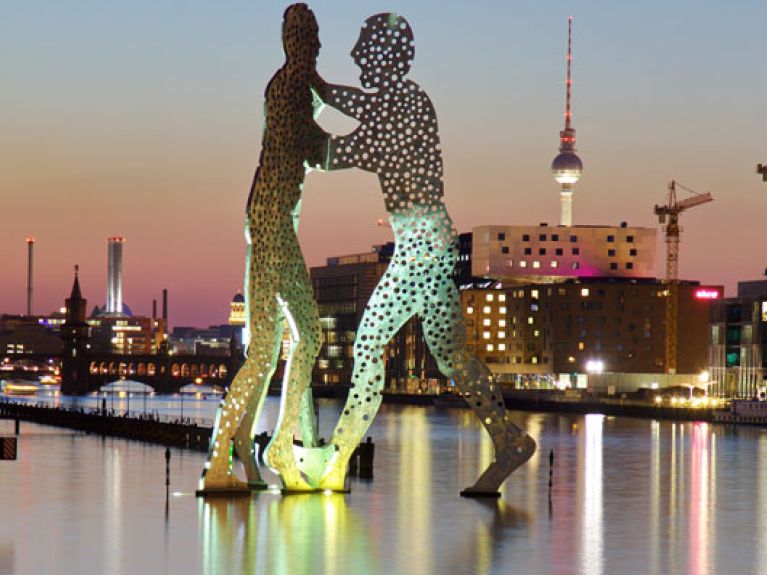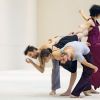Berlin – a creative laboratory
Since reunification, Berlin has long since grown out of the east and west question – to become an international creative laboratory where the future feels close enough to touch.

OST. The three giant letters on the roof of the Volksbühne theatre at Rosen-Luxemburg-Platz spell out the German word for east, and are deliberately confusing. There has been no “east” in Berlin’s central Mitte district for years, and the Volksbühne is not entirely blameless in this. Over the past 25 years, the boundaries of theatre have been explored here time and time again. Besides the classic works of director’s theatre, which have been reinterpreted at the Volksbühne, Christoph Schlingensief and René Pollesch celebrated their early successes here. The Volksbühne made political, engaged and spectacular theatre, thereby almost incidentally helping to convey to the world the message that Berlin’s centre is a stage for tireless experimentation. It was thus only logical that the thunderous rumblings in the world of theatre which accompanied the question of who would succeed Frank Castorf, who has been the theatre’s artistic director since 1992, were to be heard all over Europe. These days Berlin Mitte is a world-class location, a place in the world for which “east” is at most a geographical reference.
Chris Dercon, director of the renowned Tate Gallery in London, won the race for the post of artistic director. When talking about Berlin, he speaks in euphoric, superlative terms rather than resorting to understatement: “Large numbers of artists also come to London. But London’s development is in a rut, whereas Berlin is in a state of constant flux.” For Belgium-born Dercon, the Volksbühne with its more than 100-year history is the place where “the future of theatre” in the 21st century will be produced. Berlin has long compared itself to London and New York but has now overtaken both – so at least believes Chris Dercon.
If we take a stroll through the epicentre of the new Berlin from Rosa-Luxemburg-Platz, we will find that the question of what is east and what is west has long since become irrelevant. It is no longer sensitivities concerning the former parts of Germany that are debated in Berlin Mitte, but international issues in which the word “future” will inevitably feature. As indeed it will at the Babylon cinema, which is all about the future of film – and which, it goes without saying, is equally international. After its triumphal debut in Los Angeles, this is where Ida, the Polish movie that won the Oscar for best foreign language film, was first screened. A drama about a Jewish girl in post-war Poland, it also opened the Film Polska festival which, as its curator Kornel Miglus likes to emphasise, is the largest festival of Polish cinema outside Poland.
If we then proceed along Rosa-Luxemburg-Strasse towards Alexanderplatz, we will inevitably arrive at Karl-Liebknecht-Strasse. If street names are seen as preserving urban memories, this one has a very East German ring to it, and one that seems determined to uphold socialist traditions. Little in the way of such tradition remains here apart from the complex of prefabricated concrete tower blocks on Karl-Liebknecht-Strasse, as most of the buildings which stood as a testament to socialist-style urban development were knocked down after German reunification. The idea was to rebuild the “new Berlin”, and indeed – with a touch of postmodern irony – the Prussian City Palace, at the heart of the city. Many East Berliners considered this to be a sacrilege, as did young architects and urban activists. Was the plan suddenly to celebrate the past glory of the Hohenzollern monarchy at the centre of a reunited Berlin? To celebrate the 19th rather than the 21st century, the spiked helmet rather than the woolly hat, fine ashlar masonry rather than glass?
The criticism has meanwhile died down, as the reconstruction of the City Palace, which celebrated its topping-out ceremony in the spring of 2015, is only a shell for the Humboldt Forum, the “most important cultural project of the Federal Republic of Germany”, as State Secretary for Culture Monika Grütters stresses. With the collections of the Ethnological Museum and the Museum of Asian Art, the Humboldt Lab of the university of the same name and the World.City.Berlin exhibition of the Stiftung Stadtmuseun, Berlin’s Mitte is bringing the whole world into the palace. The founding director of the Humboldt Forum is the British art historian and museum director Neil MacGregor who, when he was first presented, stated with conviction that: “Europe is being rethought in Berlin.” Previously MacGregor ran the British Museum in London. Given such concentrated internationalism, might there not be a shortage of local colour? It is certainly the case that English, Spanish or Italian are more likely to be heard than German, let alone the local Berlin dialect, along Berlin’s Unter den Linden boulevard, which is the continuation of Karl-Liebknecht-Strasse, as well as in many of the bars and cafés in Mitte, Kreuzberg or Friedrichshain. Local colour is provided at the end of the boulevard, however, in the form of Berlin’s famous landmark, the Brandenburg Gate. Pictures of people celebrating the fall of the Berlin Wall here on 9 November 1989 were beamed around the world. Ever since, this Elbe sandstone gate that was completed in 1791 has been an iconic symbol of the city – appearing on countless tourist photographs as well as serving as the backdrop for major events. When Germany hosted the FIFA World Cup in 2006, images of the “Fanmeile” fan fest at the Brandenburg Gate were seen all over the world – the colourful celebrations in Berlin coming to symbolise a new, tolerant and open Germany. The pictures certainly had the desired effect – tourist numbers are rising every year, and Berlin has long been one of Europe’s three most popular tourist destinations alongside London and Paris.
Talking about Berlin Mitte in superlative terms naturally raises the question of what its problems might be. With an unemployment rate of nearly 14%, Mitte is one of the Berlin districts – alongside Spandau and Neukölln – facing the biggest social challenges. This is because it comprises not only the former centre of East Berlin, but also the one-time working-class neighbourhoods of Moabit and Wedding. And at times, the glamorous face of Berlin is but a stone’s throw away from its darker sides, something which the German capital also has in common with other major cities nowadays: the poor and the rich living in close proximity. What is more, it is not infrequently the case that the “poor” districts are the breeding ground for precisely the sort of creativity that is then celebrated on the “catwalk of Mitte”.
Walking away from the Brandenburg Gate, we follow Wilhelmstrasse, once the centre of German statehood and National Socialist tyranny, via the river Spree, along whose banks one after another of the insignia of the “Berlin Republic” – the Chancellery and Reichstag, the seat of the German parliament – are to be found, to Friedrichstrasse. In the past a symbol for vibrant metropolitan living, it has now been able to re-engage with its history between Checkpoint Charlie and the railway station. North of Weidendamm Bridge it merely forms the backbone of a very ordinary neighbourhood, however, with shops, apartments and a few offices. Berlin was once a laboratory here, too: just after the fall of the Berlin Wall, artists occupied the ruins of a department store – known as the Tacheles Art House, it soon came to symbolise the wild 1990s. The site has now been acquired by a financial investor. The Postfuhramt on Oranienburger Strasse experienced a similar fate: built in Moorish style, the post office building was the base for numerous art initiatives post-1990. Soon, the plan is for very ordinary people to work in very ordinary offices here, hidden away behind the exciting facade. Does this mean that Mitte – this Berlin, German, international laboratory – will soon be very ordinary too? Will the Volksbühne at Rosa-Luxemburg-Platz and the Humboldt Forum soon be but beacons in the otherwise flat and unspectacular landscape of urban existence?
Berlin would not be Berlin if it did not ask precisely these questions itself. But are the answers always the right ones? Not far from Rosa-Luxemburg-Platz, a number of containers have been piled up to create a kind of hipster favela. Known as Platoon Kunsthalle, this makeshift building has been on Schönhauser Allee for three years now. Platoon, a worldwide network which set up its first “Kunsthalle” (or art hall) in the South Korean capital Seoul in 2000, wants “to build a bridge between the key players in the cultural scene: between artists and creative individuals on the one hand and brands and institutions on the other”. Although Platoon has made some useful contributions in this context, the pendulum nowadays seems to be swinging clearly in the direction of commercial goals. Which makes the message that Chris Dercon sought to convey when he was presented as the Volksbühne’s new artistic director all the more important. After all, the theatre is supposed in future to be a planet orbited by several moons. One of the venues to be used is a hangar in the city’s disused Tempelhof Airport, while the Prater on Kastanienallee – a forum for theatrical experimentation – is also to be preserved. The Babylon cinema is to be added to the Volksbühne cosmos. “Theatre is a real and a symbolic place which creates an open situation of people for people,” Dercon explained to the art magazine Monopol. “It should not be afraid of opening up even more.” He could equally well have been talking about creative Berlin. ▪

